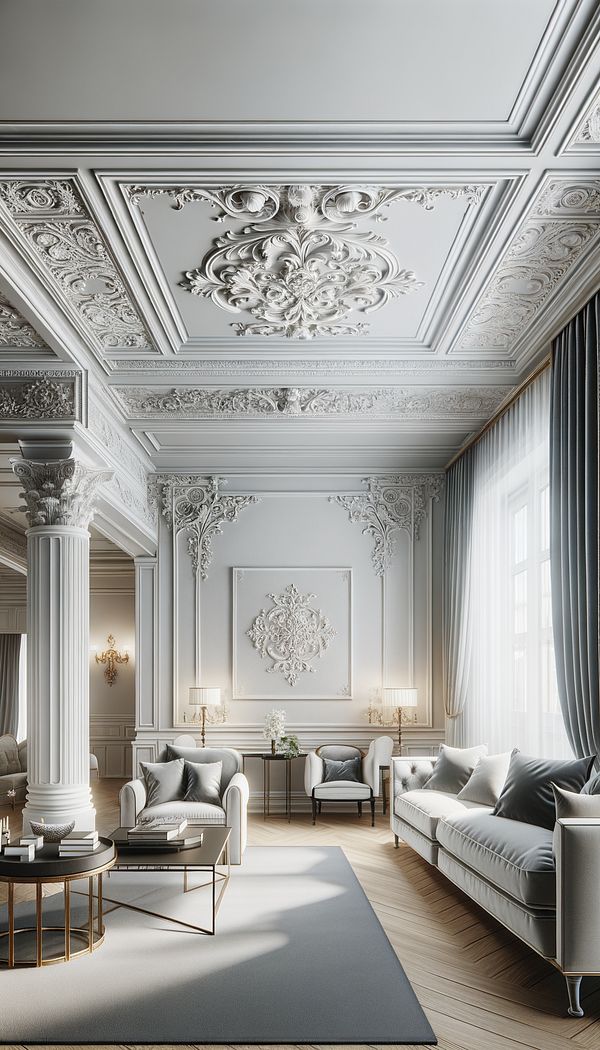What is Crown Molding?
Crown molding is a decorative trim installed where the wall meets the ceiling.
Description
Crown molding is an architectural detail that adds elegance and character to a room. It is a type of molding typically made from wood, plaster, or polystyrene, used to create a smooth transition between the walls and the ceiling. This decorative element can vary greatly in style and size, from simple and sleek designs to intricate and elaborate patterns. The choice of crown molding can significantly influence the overall aesthetic and atmosphere of a space, making it an important consideration in interior design.
Crown molding is not only a decorative feature; it also has practical applications. It can hide imperfections where the wall and ceiling meet and can be used to conceal wiring or lighting fixtures, contributing to a cleaner, more polished look. In historic homes, crown molding can also be an important element of architectural preservation, adding to the authenticity and value of the property.
In addition to its aesthetic and practical benefits, crown molding can affect the perceived height and dimensions of a room. By drawing the eye upwards, it can make a room feel taller and more spacious. This is particularly beneficial in rooms with low ceilings, where crown molding can create an illusion of height and airiness.
Usage
Crown molding is commonly found in traditional and historic homes, where it is used to enhance the architectural detail and heritage of the interior. However, it has also become popular in contemporary settings, where simpler designs can complement a minimalist aesthetic. It can be painted to match the ceiling or walls, or it can stand out as a feature in contrasting color or material. Regardless of the style of the home, crown molding can add a touch of sophistication and finish to the space.
FAQs
-
Can crown molding be used in every room?
Yes, crown molding can be used in any room to add aesthetic appeal and architectural detail. However, the style and size of the molding should be appropriate to the room's dimensions and overall design theme.
-
Is crown molding difficult to install?
The difficulty of installing crown molding depends on the material and the complexity of the design. Simple designs in lightweight materials can often be installed by a DIY enthusiast, while more intricate patterns or heavier materials may require professional installation.
-
Can crown molding increase home value?
Yes, well-chosen and properly installed crown molding can increase a home's resale value by adding to its overall aesthetic appeal and perceived quality of construction.
Practical Application
When considering crown molding for your space, it's important to take into account the scale of the room and the height of the ceilings. Choose a design that complements the room's aesthetic, and consider the material based on your budget and installation abilities. If you're aiming for a dramatic effect or wish to highlight the molding as a feature, opting for a contrasting color or more elaborate design can be effective. However, for a subtler integration, select a molding that matches the ceiling or wall color. Overall, crown molding can be a valuable addition to enhance the character and finish of your interior.
-
Architectural Elements199 articles
-
Design Styles478 articles
-
Wall Treatments & Finishes157 articles
-
AdamesqueA style related to the designs of the Adam Brothers, characterized by neoclassical elements.
-
Pickled FinishA pickled finish is a treatment applied to wood that lightens its color and enhances its grain.
-
ProportionProportion in interior design refers to the ratio between elements in a space.
-
Tudor RoseA traditional floral symbol of England, often used in architecture and design.
-
Art DecoArt Deco is a design style characterized by bold geometric shapes, rich colors, and lavish ornamentation.
